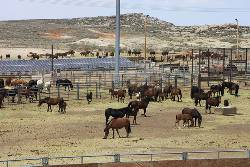Managing Wild Horses
USU Extension Ask an Expert Series - Managing Wild Horses
The large population of wild horses creates a challenge for the federal agencies charged with managing the natural ecological balance of Western rangelands. Grazing and trampling by wild horses can impact the composition and stability of plant and animal communities, causing permanent damage. Here are the methods used to manage populations of wild horses:
1. Setting Population Goals
To protect wild horses and multiple-uses of public land, Congress passed the Wild and Free-Roaming Horses and Burros Act of 1971. This act set specific and optimal population goals for wild horses. These population goals were established to protect the health of the horses and native wildlife, to prevent range deterioration, and to balance all uses of public lands.
2. Holding Facilities
The Bureau of Land Management and the U.S. Forest Service were given the authority to manage and remove wild horses from public rangelands when their numbers exceeded the optimal levels. This mainly consists of capturing wild horses and moving them to a holding facility. However, this is an expensive solution. The BLM estimates that it costs $50,000 to maintain a horse in a holding facility for its life span.
3. Adoptions of Wild Horses
The BLM has been working with the public to facilitate the adoption of wild horses. A great example of this in action can be seen in the USU Extension 4-H Wild Mustang Challenge, where 4-H members adopt a wild horse, train it, and then auction it off for funds for their clubs. Unfortunately, adoptions are not as common as they could be. While the BLM has provided for the adoption of over 235,000 wild horse and burros, the number being adopted by the public has dropped to less than 3,000 a year.
4. Further Research
It’s clear that the current management practices are jeopardizing the health of wild horses and Western rangelands.. Fortunately, USU Extension experts and others are working to find a solution through research and education. In 2017, USU Extension co-organized a National Summit on Wild Horse and Burro Management, that was held in Salt Lake City. Summit participants learned more about the impact of contemporary management policies and the available management alternatives. This information was subsequently summarized in a special issue Human-Wildlife Interactions which is published by the USU Berryman Institute. This issue is available on-line at https://digitalcommons.usu.edu/hwi/
By Terry Messmer, USU wildlife specialist


 Utah 4-H & Youth
Utah 4-H & Youth